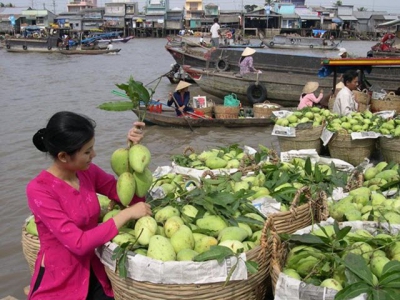An Giang province promotes agro-fishery exports

An Giang – International economic integration has helped An Giang’s key exports such as agricultural and fishery products, as well as frozen vegetables and fruits occupy many major markets like the US, the EU, Japan and the Republic of Korea.
In 2019, An Giang’s export revenue amounted to 890 million USD, increasing 5.95 percent over a year earlier.
The province’s key exports gaining high revenues include frozen sea foods with 113,000 tonnes for 273.5 million USD; rice with 454,200 tonnes for 223.8 million USD; vegetables and fruits with 9,500 tonnes for 16 million USD; and garments for 130 million USD.
Five years after the start of the implementation of the agricultural development with an application of high technology for the 2012-220 with a vision to 2030, by now An Giang province has formed many areas for the production of its key agricultural products such as rice (jasmine, glutinous), fruit trees (banana, mango), aquatic products (tra fish, shrimp), and safe vegetables.
Thanks to that, An Giang’s exports have reaped many successes, including in the scale and rate, with export revenue increasing every year. In 2016, the province’s export revenue was only 700 million USD but the figure rose to 890 million USD in 2019, with agricultural and fishery exports increasing annually.
In 2020, An Giang plans to increase its key exports for 930 million USD, and raise the figure in subsequent years.
The provincial People’s Committee has asked the departments and authorities to take this as a key task for the current stage to help enterprises weather the difficulties and boost export in the time to come. The province has also defined that the current urgent need is to boost official key exports and bring export revenue to 1.2 billion USD in 2025.
However, the province’s exports are currently facing various challenges caused by technical barriers from its markets, as well as the severe competition from regional and world countries such as Thailand, Cambodia, India, Pakistan, etc.
According to the An Giang Department of Industry and Trade, currently the province’s exports are mainly not deeply processed, with low competitiveness and without a trademark. Meanwhile, the growth in its export revenue is slower after each year.
Besides, An Giang’s main exports depend much on China, which makes up over 70 percent of its export value. As China is raising its technical barriers in terms of quarantine, the requirement in this field will become more severe.
In 2020 and subsequent years, An Giang province will pay special attention to the improving of quality and added value of its key exports such as rice, aquatic products, vegetables and fruits, and having at least two products with trademarks.
For its key products to become spearheads, Vice Director of the An Giang Department of Industry and Trade Phan Loi said the province will support farmers and enterprises to shift to the direction of high quality and added value, adding it will boost the application of scientific advances so as to diversify the processing of the exports.
Besides, An Giang province will accelerate the attraction of investment from enterprises to the production of rice and develop large-scale and organic production, focusing on the cultivation of banana and mango.
In the work of attracting investment, An Giang province will be selective and prioritise projects of high and modern technology, friendly to the environment and not land intensive but use high-quality labour force.
Có thể bạn quan tâm
 Mekong Delta farmers profit from sedge boom
Mekong Delta farmers profit from sedge boom Lác farmers in Vĩnh Long Province’s Vũng Liêm District are enjoying a bumper harvest and high prices.
 Yen The develops hill chicken under value chain
Yen The develops hill chicken under value chain Though Yen The district is home to a huge herd of chicken with protected trademark, the products’ fluctuating consumption still makes the breeders worried.
 Advanced technology crucial to improve cashew output
Advanced technology crucial to improve cashew output Cashew yield could surge up to 40 percent if comprehensive advanced technology is applied to cultivation process
 Fruit-vegetable surpasses crude oil in export earnings
Fruit-vegetable surpasses crude oil in export earnings The export value of fruit and vegetable in the first four months of 2018 has exceeded earnings from crude oil for the first time ever
 High air freight costs hinder Vietnamese fruit exports
High air freight costs hinder Vietnamese fruit exports The shipping fee per kilogram of fruit can be three times higher than the price at farmer’s garden.